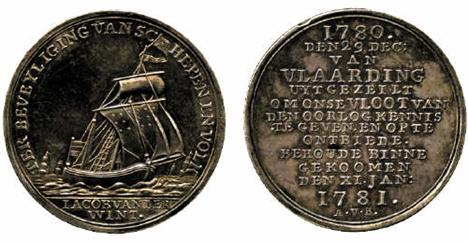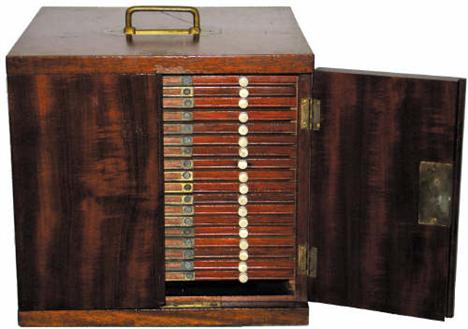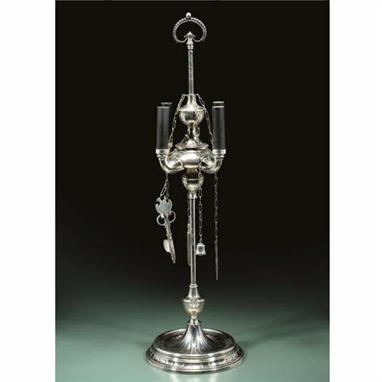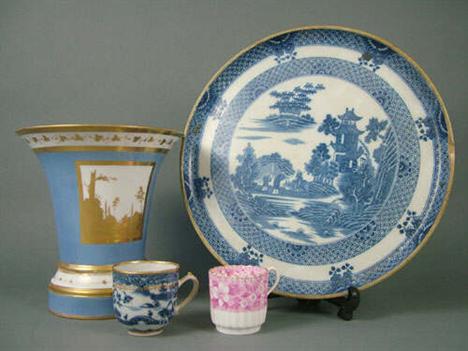BRITISH COMMEMORATIVE MEDALS, Great Britain, Charles II, Charles II and Catherine of Braganza, Marriage, Silver-gilt Medal, 1661, by George Bower, laureate bust of King right, in armour, rev bust of Catherine right, her hair tied into small coronet, lovelocks on right shoulder, lettered edge, HINC PROGENIEM … ORBVM, 54mm (MI 482/94). Good very fine, the gilding contemporary, a rich deep colour with a little light tooling, extremely rare. The medal is recorded in Medallic Illustrations with two edge legends of which only the Bodley [Ashmolean] specimen has the spelling ORBVM for ORBEM
We found 534338 price guide item(s) matching your search
There are 534338 lots that match your search criteria. Subscribe now to get instant access to the full price guide service.
Click here to subscribe- List
- Grid
-
534338 item(s)/page
BRITISH COMMEMORATIVE MEDALS, Great Britain, George I, The Escape of Princess Clementina from Innsbrück, Silver Medal, 1719, by Otto Hamerani, bust of the Princess left, rev the Princess makes good her escape in a chariot, Italian landscape behind, 48mm (MI 444/49; Woolf 36:1). Light wear to high points, otherwise nearly extremely fine. Princess Clementina Sobieski (1703-1735) was betrothed to Prince James Stuart. George I was averse to the marriage and to please him the Princess was arrested and imprisoned in Innsbrück Castle. Eventually she escaped to Bologna and was married to James, at that time in Spain, by proxy.
BRITISH COMMEMORATIVE MEDALS, Great Britain, George II, William, The Duke of Cumberland and William IV, Prince of Orange (1711-1751), Silver Medal, 1747, by T Pingo [obverse], armoured bust of Cumberland right, rev bust of William left, wearing Sash and Badge of Order, 32mm (MI 634/326; vL supl XXII). Light wear to high points and light surface marks, otherwise very fine and rare. When the the French army entered Flanders in April 1747, William was appointed General Stadtholder of the United Provinces and Commander of the Dutch army. The Duke of Cumberland was to command the British army
BRITISH COMMEMORATIVE MEDALS, Great Britain, George IV, Plymouth Dockyard renamed Devonport, 1824, Silver Medal, by R Ellis and J Ramsey, Neptune standing in conch chariot driven by two hippocamps, Fame flies above, rev inscription in twelve lines, 55mm (BHM 1244); together with a similar specimen in Copper. First with a few light surface marks, toned good very fine and rare, the second extremely fine. (2)
BRITISH COMMEMORATIVE MEDALS, Great Britain, George IV, Plymouth Dockyard renamed Devonport, Silvered-metal Medal, 1824, by R Ellis and J Ramsey, Neptune standing in conch chariot driven by two hippocamps, Fame flies above, rev inscription in twelve lines, 55mm (BHM 1244). A few light marks, mainly to the edge, very fine.
BRITISH COMMEMORATIVE MEDALS, Great Britain, Victoria, The Golden Jubilee, 1887, the official Gold Medal, 82.22g, by Sir J E Boehm and [reverse] Frederick, Lord Leighton, engraved by L C Wyon, crowned and veiled bust left, rev the Queen enthroned surrounded by seven figures of the Arts and Industries of Britain, 58mm (BHM 3219), in red leather case of issue. Extremely fine, however a few light surface marks.
BRITISH COMMEMORATIVE MEDALS, Great Britain, Victoria, The Golden Jubilee, 1887, the official Silver Medal, by Sir J E Boehm and [reverse] Frederick, Lord Leighton, engraved by L C Wyon, crowned and veiled bust left, rev the Queen enthroned surrounded by seven figures of the Arts and Industries of Britain, 58mm (BHM 3219), in red leather case of issue and with printed descriptive details of the reverse design. Extremely fine, however a few light surface marks.
COMMEMORATIVE MEDALS, Austria and Holy Roman Empire, Charles VI, Holy Roman Emperor (1685-1711-1740), The Coronation of Elisabeth Christine of Brunswick-Wolfenbüttel, Silver Medal, 1723, by Andreas Vestner, conjoined busts right, he laureate, rev Eternity and Providence with armorial shield, 37mm (BDM VI, 250). Extremely fine with light, even tone.
COMMEMORATIVE MEDALS, USA, Canada and the Americas, The Escape of the Dutch Fishing Fleet, Silver Medal, 1781, by Adriaan van Baerll, a fishing boat under full sail, in ex, IACOB VAN DER WINT, rev legend in thirteen lines, initials below, 32mm (Betts 574; Ford XIII, 234). Good extremely fine with attractive light tone. Following the Netherlands joining the League of Armed Neutrality, the British promptly captured some 200 Dutch merchant ships carrying considerable cargo valued at 15-million Gulden. Van der Wint however, escaped capture.
COMMEMORATIVE MEDALS, Turkey and the Ottoman Empire, 1686, House of Habsburg, The Siege and Capture of Ofen [Budapest], and Bombardment of Coron [Morea], Light Wooden Draughtsman, from a medal by Martin Brunner, Imperial Eagle flies over besieged town, with cannon firing, PANNONIÆ TOTAM DAT BVDA CORONAM, chronogrammatic legend in cartouche below, 55mm (MI 243/29 [this with reverse of the bombardment of Morea by the Venetian fleet], and footnote, where this type mentioned). Extremely fine and extremely rare. The design as catalogued is, in fact, the reverse of a draughtsman of the Duke of Marlborough as Commander-in-Chief, 1702, by Martin Brunner:- the Duke on horseback galloping right, IOH D MARLEBVRG ANGL EX DVX (Himmelheber 238 – this also with reverse of the bombardment of Morea).
COIN CABINETS, A plain “cube” style mahogany coin cabinet by Warings of Liverpool, 242mm wide x 230mm high x 242mm deep, containing 19 double-pierced trays, all 33mm apertures, plain doors, white pulls, recessed top brass handle. Some chips and scratches externally, light corrosion on label holders, but sound and useful.
A brass Cheutin oil opera lamp with curved bevelled glass lenses, the side lens with cut multi-pointed star on blue ground, the front lens plain (cracked to corner), and flattened conical oil reservoir mounting for offside use (screw missing), together with a brass Lucas King of the Road back light, no. 638 (clear lens cracked), an Esso promotional petrol tanker and a British Jaeger black faced eight day dashboard clock.
A good heavy baluster goblet circa 1700 the generous funnel bowl with solid base, set on a teared inverted baluster stem and folded conical foot 18.8cm., 7.375in. some very light typical scratching to the interior of the bowl For the form, see the catalogue, 'The Baluster Family of English Drinking Glasses', Delomosne and Son Ltd., May 1985, pp.6-7, fig.1 Provenance With Delomosne and Son Ltd., North Wraxall Private Collection
An Italian silver oil lamp, most probably Gregorio Spinazzi, Rome, circa 1770 circular, with detachable shaft sections, covered four-light oil recepticle, chain-hung snuffer, scissors, pick and tweezers, detachable beaded handle, silver shaft, iron core, wood base, chased with stiff leafage on a reeded ground, fitted for electricity 80cm, 31 1/2in high 3063gr, 98oz 10dwt all in This maker's mark was also used by the Roman goldsmiths Domenico Gabriele Mariani (1697-1756) andÊGiuseppe Nepoti (1677-1753), and continued in use by their widows until 1762.
h.M.S. Aboukir: the presentation ivory mallet used to launch the ship on 16th. May 1900, carved with the monogram G.S.M. for Admiral Sir George Digby Morant and his wife Sophie, and the legend Fairfield Shipbuilding & Engineering Co. Ltd, together with a contemporary photograph of Admiral George Digby Morant. provenance: by direct family descent Admiral Sir George Digby Morant was born in Carrickmacross, County Monaghan in 1837. In 1850 he joined the navy and served in Burma, the Baltic, Crimea and China and was promoted to the rank of Admiral. At Pembroke and Chatham he was Admiral Superintendent of the dockyards overseeing the launch of a number Her Majesty’s Ships. He was knighted and died in London in 1921. hMS Aboukir was a Cressy class cruiser of 12,000 tons built by Fairfield Shipbuilding & Engineering Co Ltd, Govan, Scotland, in 1900. the Cressy-class vessels had rapidly become obsolete due to the great advances in naval architecture in the years leading up to the First World War. At the outbreak of the war, these ships were so clearly unfit for combat that they were mostly staffed by reserve sailors. The Admiralty was planning to withdraw them, when the Aboukir and two of her sisters, the Cressy and Hogue were lost to submarine attack. The Aboukir was one of four units that made up Rear Admiral Henry H Campbell’s Seventh Cruiser Squadron. Owing to the obsolescence of these ships, the squadron was nicknamed the Live Bait Squadron. In September 1914 Aboukir and her sister ships the Hogue and Cressy were patrolling the Broad Fourteens of the North Sea. Owing to poor weather they were without destroyer escort. While steaming at 10 knots in line ahead early morning on 22 September, they were spotted by the U-9, commanded by Lt. Otto Weddigen. Weddigen ordered his submarine to submerge and closed the range to the unsuspecting British ships. At close range, he fired a single torpedo at the Aboukir. The torpedo broke the back of the Aboukir and she sank within 20 minutes with the loss of 527 men. The captains of the Cressy and Hogue thought the Aboukir had struck a floating mine and came forward to assist her. They stood by and began to pick up survivors. At this point, Weddigen fired two torpedoes into the Hogue, mortally wounding that ship. As the Hogue sank, the captain of the Cressy realised that the squadron was being attacked by a submarine, and tried to flee. However, Weddigen fired two more torpedoes into the Cressy, and sank her as well. The entire battle had lasted less than an hour, and cost the British three warships, 62 officers and 1397 ratings. Coming on the heels of the loss of the light cruiser HMS Pathfinder earlier to another submarine attack, this incident established the U-boat as a major weapon in the conduct of naval warfare.
a pair to E.W. Pottington; Defence and British Gas Light Company Limited silver Long Service Medal (named and dated 1926), two School Attendance medals in silver and bronze; together with ARP badge and Hull Dispatch Riders badge 1915, this last rare, all extremely fine in box/case as issued, (6).
four to Major [Sir] W.E. Crum, Calcutta Light Horse, Indian Army: Order of the British Empire (O.B.E.), Civil Division, Officer’s breast badge, type 1; British War Medal; Delhi Durbar, 1911 (unnamed); Volunteer Force Long Service, Geo. V (Major, Cal. Lt. Horse), officially engraved, mounted for wearing, extremely fine; together with a mounted group of 4 dress miniatures, two riband bars and a Calcutta L.H. badge (11) Major Sir Walter Erskine Crum, Kt. Batchelor, O.B.E. (1874-1923). Served as a Major in the Calcutta Light Horse (1913-20) and was both President of the Bengal Chamber of Commerce as well as a Member of the Indian Imperial Legislative Council between 1919 and 1920 (O.B.E., 1918; knighted 1920).
A Victorian lacquered brass monocular microscope, late 19th century, with coarse and fine focus adjustment above adjustable stage hinged onto Y-shaped foot with pivoted mirror and signed BAKER, 244 High Holborn, London to rear, in original mahogany box with light magnifying glass on stand, spare lenses and other accessories, box 45cm high.
An inlaid mahogany mantel timepiece, Unsigned, 19th century The single fusee movement with outside platform lever escapement mounted on the light bulb shaped backplate, with convex silvered brass Roman numeral circular dial in balloon shaped case with satinwood oval cartouche to the concave front, on moulded base with brass bracket feet, 29cm high.
A full size live steam open crank horizontal mill engine, the single cylinder with approximately 2 5/8in bore x 4 1/2in stroke, cross-head guides, eccentric driven steam valve, 24 inch diameter spoked flywheel. The engine has a govenor mounting bracket but has never had a speed govenor fitted from new. Finished in light blue paintwork and mounted on a polished mahogany plinth. Engine base 34inch by 10 1/2 inches.
A 5 inch gauge 0-4-0 battery electric diesel design locomotive Trog, built in 1984 by the late Mr W J (Bill) Manley of Topsham Nr Exeter. The engine was run at Tiverton MES until the last two years. Now requires a new battery. The locomotive is finished in light blue and black livery and comes with a display track. Length 25 inches (63cm).
Selection of china and glassware, to include a Paris porcelain vase on stand with light blue ground and two gilt landscape panels, 18.5cm high, two cut glass vases, Spode blue and white and red and white cups and saucers, printed marks, circular stand decorated in blue and white with a central landscape panel and geometric patterned borders, 29cm diameter, and other items, a/f
John Mollo b.1931- ''A Light Company Officer Of The 1st Regiment Of Foot Guards, In Frock Dress, numbered 77; watercolour, silhouette, signed and dated 63: together with three other similar watercolour silhouette studies of officers each for the ''Mollo's Military Profiles, or Regimental Silhouettes 1800-1830'' each signed and dated 63 and numbered 128,130,84, 18x12cm, oval, each, all bearing Mollo's label verso, (4)
-
534338 item(s)/page











![COMMEMORATIVE MEDALS, Turkey and the Ottoman Empire, 1686, House of Habsburg, The Siege and Capture of Ofen [Budapest], and](http://lot-images.atgmedia.com/SR/1806/2712033/1647-11-1806_468x382.jpg)














![four to Major [Sir] W.E. Crum, Calcutta Light Horse, Indian Army: Order of the British Empire (O.B.E.), Civil Division, Offi](http://lot-images.atgmedia.com/SR/10011/2712024/515-113-10011_468x382.jpg)


















